PUBLICATIONS RECEIVED BY WIRG MEMBERS
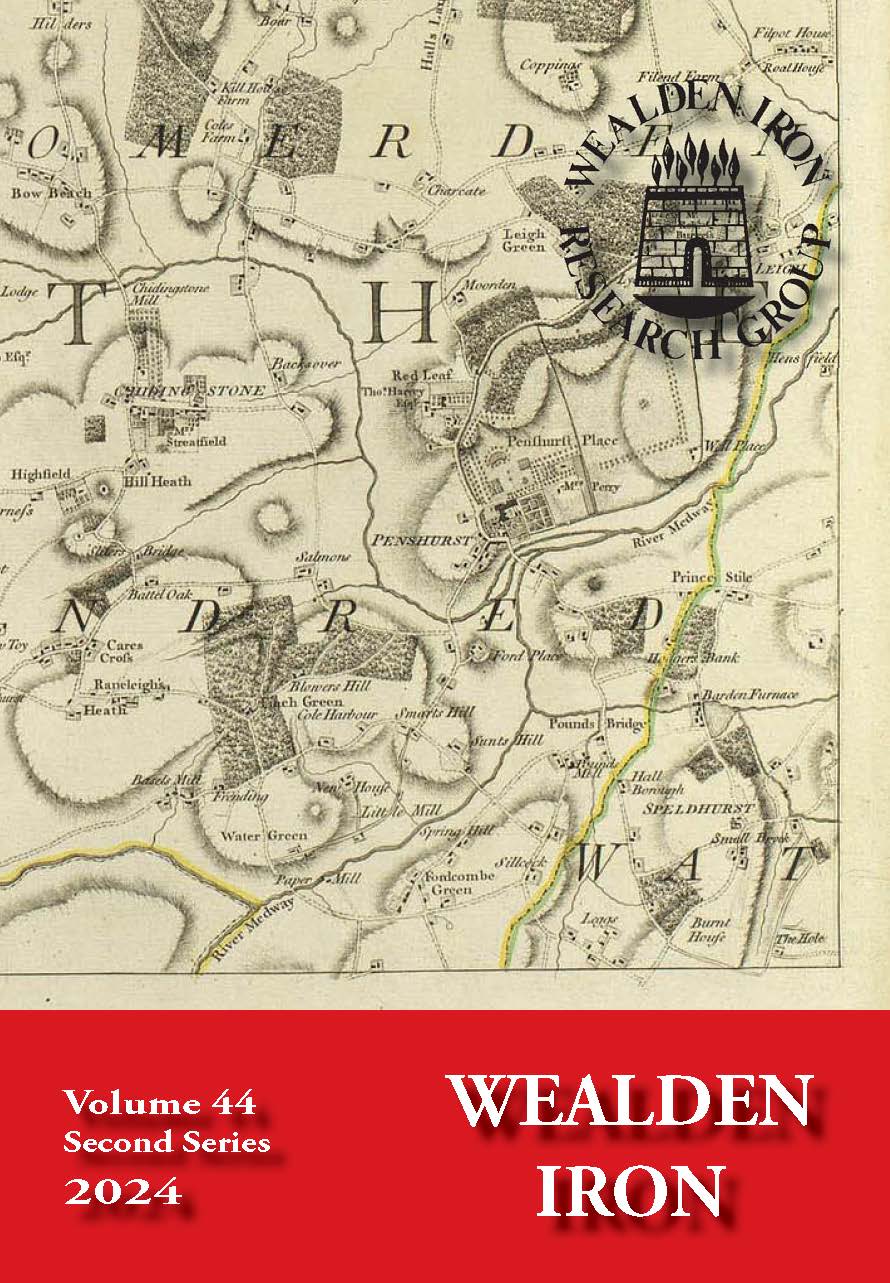
Wealden Iron
WIRG publishes an annual Bulletin of research, entitled Wealden Iron. The contents of these volumes are listed on separate pages as follows:
Series I (1969 – 1980): See the contents of each volume which can be downloaded as a pdf file.
Series II (1981 to date): See the contents of each volume which can be downloaded as a pdf file.
Prospective authors of articles for future Bulletins should be familiar with the Notes for Authors
WIRG Newsletter
WIRG publishes a twice-yearly Newsletter for its members.
BOOKS ABOUT THE IRON INDUSTRY AND ITS PRODUCTS
Wealden Iron by Ernest Straker (1931)
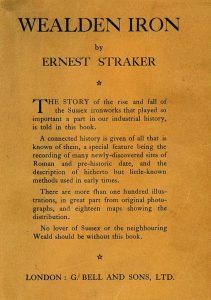 OUT OF PRINT
OUT OF PRINT
From the sleeve notes: Wealden Iron deals with the former Ironworks in the counties of Kent, Surrey and Sussex. It relates the history of this industry from its early beginnings to its complete and very definite end towards the close of the 18th century. The book also includes a survey, made by the author, of the existing remains of the ironworkings.
The story of this industry has, however, far greater significance than a mere study in local archaeology. Its history is very clear cut and self contained, yet it throws considerable light on the industrial and economic life of the country as a whole over a period of more than 300 years. You can download a searchable pdf of the book (116.3Mb) NB: note the file size
NB: The Contents list on page x has hyperlinks to the beginning of each chapter to facilitate reading a particular section of the book. There are also hyperlinks on page xi to each of the sections of the gazetteer and to the pages of maps.
The Iron Industry of the Weald by Henry Cleere and David Crossley (2nd ed. Merton Priory Press 1995)
 OUT OF PRINT
OUT OF PRINT
From the sleeve notes: The Weald of Kent, Surrey and Sussex form the site of the major concentration of ironmaking in Britain during two distinct periods of the island’s history; during the Roman occupation of AD43-400 and in the 16th and 17th centuries. This book surveys the evidence derived from excavation, fieldwork, documentary studies and experimental archæology carried out by the Wealden Iron Research Group. It includes chapters on geology and topography of the region, the iron industry during the successive periods of operation, and the technology of the direct and indirect ironmaking processes, together with a detailed gazeteer of sites.
You can download a searchable pdf of the book (26.5Mb). NB: The Contents list on page v has hyperlinks to the beginning of each chapter to facilitate reading a particular section of the book.
The Wealden Iron Industry b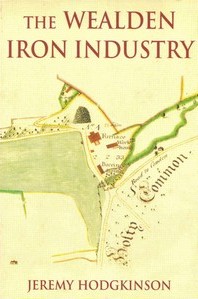 y Jeremy Hodgkinson (2008), The History Press 160pp., 30 col. illus., 75 bw illus., index; ISBN 9 780752 445731 – Price £20.00
y Jeremy Hodgkinson (2008), The History Press 160pp., 30 col. illus., 75 bw illus., index; ISBN 9 780752 445731 – Price £20.00
From the cover notes: For two periods of British history – the first part of the Roman occupation and the Tudor and early Stuart periods – the Weald of south-east England was the most productive iron-producing region in the country. Looking across the tranquil Wealden countryside, it is hard to identify anything that hints at its industrial past. Yet 400 years ago, nearly 100 furnaces and forges roared and hammered there, the smoke from charcoal-making curling up from the surrounding woods and the roads bustling with wagons laden with ore and iron sows. Many British naval campaigns, including the Spanish Armada, the wars against the Dutch, and the Seven Years’ War, relied on Wealden iron cannon, the pressures of conflict driving forward the development of iron-producing technology. For a time the economy of the whole area was dominated by the production of iron and its raw materials, providing employment, generating prosperity, and shaping the landscape irrevocably. Drawing on a wealth of local evidence, this book explores the archaeology and history of an area whose iron industry was of international importance.
Hammer and Furnace Ponds by Helen Pearce, Pomegranate Press, Lewes, 2011; 96pp., 15 col. illus., 26 bw illus., index; ISBN 9781907242151 – Price £8.99.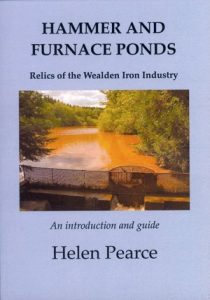
Back cover notes: They beautify the woodlands of the Kent and Sussex High Weald and adjacent parts of Surrey, but they were created to power what has been described as the country’s first industrial revolution.
Helen Pearce’s walker-friendly guide to the rich crop of surviving hammer and furnace ponds in the area traces the history of iron exploitation from pre-Roman times, but concentrates on the 16th and 17th centuries when the Weald throbbed to the sound of trip hammers.
The book includes:
A complete gazetteer of surviving ponds, with map references and access details
A list of museums with iron industry displays
A glossary of terms and ideas for further reading
There is more at the website www.hammerpond.org.uk
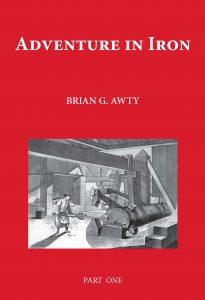 Adventure in Iron: The blast furnace and its spread from Namur to northern France, England and North America, 1450-1650; a technological, political and genealogical investigation by Brian G. Awty, Wealden Iron Research Group, 2019; 997pp; 302mm x 219mm 14 black and white illustrations; 21 maps of sites; two appendices; detailed contents pages, footnotes and bibliography; general and names indexes; case bound in a two-volume set; ISBN 9781916042308 – Price £45.00 +p&p.
Adventure in Iron: The blast furnace and its spread from Namur to northern France, England and North America, 1450-1650; a technological, political and genealogical investigation by Brian G. Awty, Wealden Iron Research Group, 2019; 997pp; 302mm x 219mm 14 black and white illustrations; 21 maps of sites; two appendices; detailed contents pages, footnotes and bibliography; general and names indexes; case bound in a two-volume set; ISBN 9781916042308 – Price £45.00 +p&p.
Synopsis: Making extensive use of British and continental archival and published sources, many previously unexplored in this context, Adventure in Iron describes the way in which the early history of the indirect ironmaking process in England is integrated into the parallel story on the Continent, and provides a detailed biographical approach to the migration of ironmasters and workers from the Continent to South East England in this period. ORDER HERE
A Gazetteer of the British Iron Industry, 1490–1815 by Peter King, BAR publishing, Oxford, 2020; 738pp., 2 tables, 44 maps, index; 2 volumes; ISBN 9781407315126 (Volume set) – Price £173.00.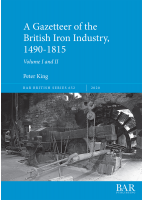
Back cover notes: A new process of making iron, using a blast furnace and a forge, both powered by water, was introduced into the Weald in the 1490s, and spread to other parts of England and Wales from the 1550s. This book provides a history of every ironworks of the charcoal blast furnace period, except the Weald. It also covers early coke ironworks (built before 1815) and water-powered bloomeries (of the previous technology). After introductory material on the industry generally, each chapter deals with the ironworks of one district, including also other water-powered mills processing iron, steel furnaces, early ironworks powered by steam engines, and a few other works. Blade mills (and cutlers wheels), which provided the initial cutting edge for tools are not included in those areas where they are ubiquitous. The period covered is an era in the technology of an important industry in Great Britain.
The information about the sites in the Weald has been largely derived from the WIRG Online Database.
Available from BAR Publishing
The Historical Geography of the Wealden Iron Industry by Mary Cecilia Delany (1921)
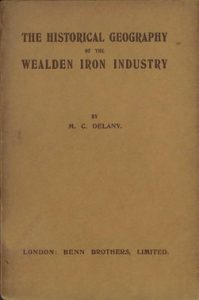 OUT OF PRINT
OUT OF PRINT
This short study was published as the first in a series of research monographs by the Geographical Association. In a contemporary review, M. S. Giuseppi wrote, “Miss Delany has well kept the first object of the series and her own title in view by devoting the greater part of this little book to a consideration of the geographical and other natural features of the Weald which made possible the continuance of its iron industry over so long a period.” The author drew extensively from previously published sources and it is apparent that she did not carry out any original research in its preparation. Instead, it was intended as a guide for future research.
Copies are available on the second-hand market and a digitised copy is available for on-line study or download here.
History of the British Iron and Steel Industry by H. R. Schubert (1957)
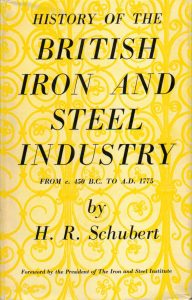 OUT OF PRINT
OUT OF PRINT
Although dated, this is probably still the best general survey of the industry as a whole, and includes much of the early research into the Weald by Straker and others. It divides the industry into its two basic iron-making methods: the direct and indirect processes. Within those two sections it covers the history and the technology, drawing on continental as well as native examples, and there are several appendices which include useful sources, such as inventories and production statistics.
Copies are available on the second-hand market and a digitised copy is available for on-line study or download here.
The Queen’s Gunstonemaker: An Account of Ralph Hogge, Elizabethan Ironmaster & Gunfounder by Edmund Teesdale (Lindel 1984)
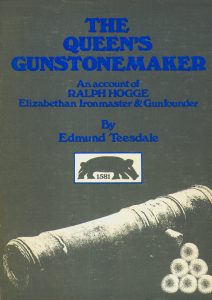 OUT OF PRINT
OUT OF PRINT
From the sleeve notes: Ralph Hogge lived and worked in the Sussex villages of Maresfield and Buxted. This account of his life and times provides a new glimpse into the sixteenth century Wealden iron industry and its gun-founding. The writer, Edmund Teesdale, who lives in the house Hogge built at Buxted in 1581, spent several years researching the material, some of which has not been recorded before.
The book looks at Hogge’s probable origins. It gives an account of Parson William Levett, the Rector of Buxted and gunfounder to Henry VIII, under whom Hogge served his apprenticeship.
Hogge is shown as a central figure in attempts to curb the smuggling of English cast-iron cannon to the continent, a trade which so disturbed the Privy Council in the latter part of Elizabeth’s reign
The Fuller Letters: Guns, Slaves and Finance 1728-1755 edited by David Crossley and Richard Saville (Sussex Record Society 1991)
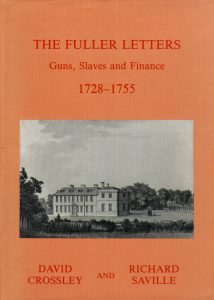 OUT OF PRINT
OUT OF PRINT
From the sleeve notes: This letter book records the rise to wealth and influence of the Fuller family of Brightling Park. Originally from humble beginnings in an inhospitable and forested part of the Weald of Sussex, they had in the eighteenth century diversified into slave owning in Jamaica, expanded their ironfounding and gun-casting in the Weald and greatly enlarged their Sussex estates, and by mid-century held significant holdings in London stocks. The letters explain how these business interests worked, and give the reader unique insights into the life of an eighteenth century landowner.
The letters also contain the only major surviving record of the charcoal iron industry to include substantial comment on the technical problems, how furnaces were operated, how guns were cast, and where they were sold.
The Sussex Record Society has made available a digital edition (pdf) of this publication which can be accessed HERE.
Gunfounding in the Weald in the sixteenth century by Edmund B. Teesdale (Royal Armouries 1991)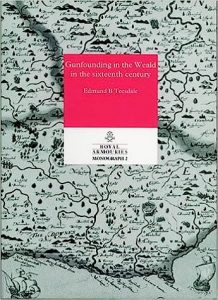
OUT OF PRINT
Back cover notes: For over a hundred years, from the 1540s, England led the world in the manufacture of cast-iron cannon. The growth in gunfounding in the second half of the 16th century was rapid and the output of cannon rose dramatically. This is the first detailed study of the formative years of the industry which was based in the Weald of Sussex and Kent.
A pioneering work which focuses on the men who led the world in gunfounding technology, it analyses their output, who bought the cannon they made and how successful they were. The result of a long personal interest, this superbly researched book will appeal to the economic and military historian as well as the general student of a fascinating and sometimes little known area of England’s industrial past.
Prince Rupert’s Patent Guns by Sarah Barter Bailey (Royal Armouries 2000)
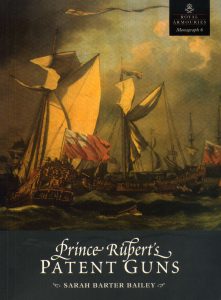 OUT OF PRINT
OUT OF PRINT
Back cover notes: The basic technology behind muzzle-loading artillery did not change very significantly between the late 16th and early 19th centuries, but throughout the period there were attempts to improve both the accuracy and the safety of guns and gunfounding. The Royalist cavalry general, Prince Rupert, was involved in one of these attempts while enjoying a quiet retirement as Constable of Windsor Castle after the Restoration of his cousin, King Charles II. In 1671, he obtained a patent for a secret process, whereby cast iron cannon could be made ‘as handsome and convenient as brass ones’, but also lighter and, most importantly, cheaper. This monograph traces the story of these guns, through a myriad of contemporary documents to the surviving guns themselves, describing the financial, administrative and social ramifications of this episode which are revealed in fascinating detail. It also lists the total number of these guns delivered into the Ordnance Office stores, giving their sizes and weights.
British Cast-iron Firebacks of the 16th to mid 18th Centuries by Jeremy Hodgkinson (Hodgers Books 2010)
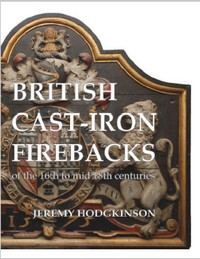 OUT OF PRINT
OUT OF PRINT
Back cover notes: Firebacks began to be made in Britain in the first half of the sixteenth century. From the purely functional purpose of protecting the back of the fireplace and reflecting heat into the room, it was not long before the opportunity was taken to embellish their plain surfaces. Their decoration provides us with a reflection of the social history of the times in which they were made, whether in the heraldry of royalty and the landed class, the religious and political turmoil of the Stuart period, or the beginnings of the Enlightenment and the rediscovery of classical literature.
Illustrated with more than 300 photographs, this first survey of British firebacks sets out to explore their development and variety, and to provide interpretation, where possible, of the decoration to be found on them. The illustrations are to scale so the relative sizes of firebacks can be compared, and there is a comprehensive gazetteer with full details of each fireback shown.
The text of this book, without the illustrations, can be accessed HERE.
A website about firebacks, including a searchable database, is available at https://hodgers.com/firebacks
© Wealden Iron Research Group 2000-24
